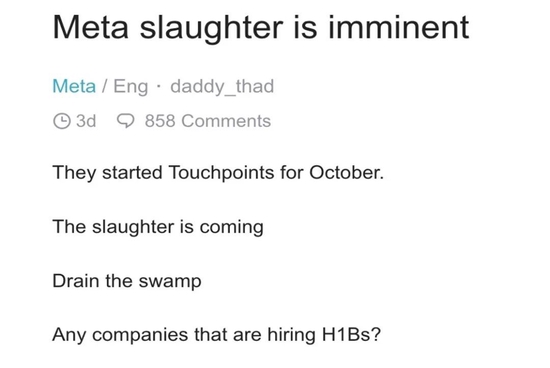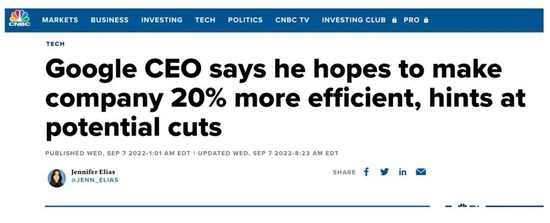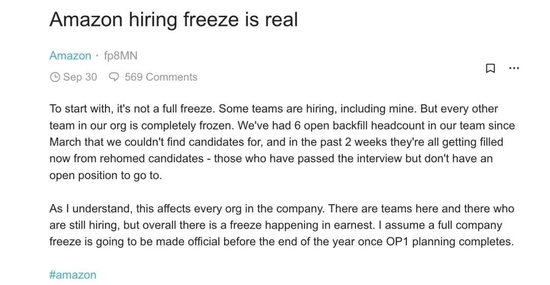your current location is:Home > Finance > depthHomedepth
In the matter of layoffs, there are so many "eyes" in Silicon Valley factories

When it comes to layoffs, we can often see the art of language in some tech companies. For example, turning the layoff letter into a "graduation notice", describing business closure as "structural optimization", and describing dismissal and elimination as "transporting talents to the society".
Recently, under the pressure of the economic downturn, Meta, Google, Amazon and other Silicon Valley manufacturers have not only joined the ranks of "language artists", but also various activities at the practical level are emerging one after another: frozen recruitment, business Restructuring, internal group transfer, performance appraisal, tearing up offers... Although everyone is silent about layoffs, a series of operations actually point to staff reduction.
A massive layoff involving tens of thousands of people has already begun. The big factories seem to be calm, but the inside is actually turbulent.
|Meta opens the "30-day list", which may affect 12,000 people
Over the past few months, Zuckerberg has seemed unabashed about his plans to be tough on employees. First, the employees were "vaccinated" at the company's internal meeting. He said that not all Meta employees meet the company's standards. Everyone is required to work harder and self-pressurize. If they don't want to do it, they can leave at any time.
In a weekly Q&A with employees late last month , Zuckerberg made it clear that Meta would be reorganizing its team and laying off a plan to cut expenses and adjust priorities , the first major effort since Facebook's founding in 2004. Scale budget cuts. In addition, Zuckerberg also bluntly stated that " Meta will steadily reduce the growth of the number of employees, and the scale of Meta in 2023 will be smaller than this year. "
 Image taken from Bloomberg
Image taken from BloombergBut Meta isn't currently making massive one-off layoffs like Snap, but instead employs a "blunt knife" and enhanced performance improvements to let employees go. Prior to the meeting, Meta executives had proposed to the board of directors that at least 15% of the staff be marked as "Need Support" during the internal review process, according to anonymous messages from Meta employees on Blind.
In Meta's employee evaluation process, those who are marked as NS mean that they have failed to achieve performance goals, and recently, once an employee is listed as NS, it means that they have fallen into a crisis of unemployment. Since July this year, Meta’s executives have successively issued NS indicators to each team, obliging each department to select a certain percentage of personnel to be included in the list.
After being listed in the NS, those employees who enter the PIP will have 30 days to seek regrouping internally, and if they cannot find a position in other departments after 30 days, the employee will be fired. Many employees say that Meta's plan is ostensibly to promote employee progress, but the reality is that many people are being forced to leave.
According to Meta's second-quarter financial report, it has a total of 83,533 employees worldwide. If this performance improvement is carried out at a rate of 15%, more than 12,000 employees will be affected, and many employees will start to search for a home. Judging from the current constantly updated news, the objects handled by Meta are not only junior employees, but many team managers are also affected.
 Image taken from Blind
Image taken from BlindThe current situation of Meta is indeed not optimistic. Its market value has dropped from more than 1 trillion US dollars in September 2021 to less than 400 billion US dollars currently. The growth of users and revenue of social family is obviously weak, and the Metaverse is still burning wildly. money. Cost-cutting seems imperative for Meta, and the most immediate "cost-cutting" comes from cutting staff.
|Google will also bid farewell to the "retirement" era and start layoffs from internal integration
While Meta has been the most talked-about lately, layoffs and cost-cutting plans at other Silicon Valley companies are actually underway, and not small.
Among them, Google, which has always been regarded as an iconic pension factory in the past, has recently revealed a wolfish atmosphere.
At the Google Code Conference in the middle of last month, Google CEO Pichai publicly stated that he wants to improve the company's efficiency by 20% in the face of increasing economic uncertainty and slowing advertising revenue. In his speech, he mentioned two key issues. One is that the company's efficiency has become "slower" after the number of employees has surged; the other is that Google is taking some measures to improve efficiency, citing the integration of YouTube Music and Google Play Music in the past. An example in a product that hints at divisional consolidation.

At that time, everyone analyzed that the 20% figure mentioned by Pichai was not a casual statement. If it was expressed in public, it meant that Google had already conducted a lot of investigations and demonstrations, and finally this ratio was determined layer by layer.
Immediately after that, the first shot of Google's layoffs was fired. In mid-September, Area 120, Google’s internal R&D innovation incubator, announced a downsizing, cutting seven out of 14 ongoing R&D projects. Area 120 is an entrepreneurial project launched by Google in 2016, mainly to provide a platform for employees to test new ideas and incubate new projects.
Area 120 has hatched a lot of products, such as HTML5 game platform GameSnacks, video platform Tangi and Shoploop, Internet travel APP Touring Bird, etc. Many products have been subsequently integrated into Google's main product system. In addition to Qaya, the online storefront service product launched at the end of last year, the axed projects also include financial accounting projects including Google Sheets, shopping-related products, AR/VR analysis climate and other related projects that have just begun.
This time, about half of the employees in Area 120 were affected. Google gave these employees 90 days to transfer internally. If they cannot find positions, these employees will be fired in January next year.
As can be seen from the cut of Area 120, Google's departmental integration seems to have started from the low-yield department, and many people speculate that the department in Google's The other bets will become the focus of integration later.
In addition to having already begun to implement internal project integration, Google is also implementing stricter performance management at a broader employee level.
Google has launched an internal initiative called "Simplicity Sprint" from July to solicit ideas and suggestions from all employees of the company on how to "get better results faster" and "eliminate waste", using to further help the company cut expenses.
 Image taken from Blind
Image taken from BlindIn recent months, Google has begun to pressurize layers from management to execution, telling employees that they need to work hard to meet expectations or prepare for layoffs. Since the beginning of this year, Google's revenue has fallen short of expectations for two consecutive quarters. In the second quarter, its net profit fell by 14% year-on-year, and the growth rate hit a new low in the past two years.
Recently, Google executives have been giving employees a shot, and if the company's upcoming third-quarter results don't meet expectations, the company will officially start laying off employees.
|“Recruiting maniacs” Amazon slows down, frozen recruitment and project closures are coming one after another
The pressure of the general environment is increasing, and Amazon, which has been the most active, diligent, and versatile in recruiting people in the past, has clearly calmed down.
While Amazon has yet to stop hiring company-wide (AWS continues to hire), the popularity has plummeted. A Silicon Valley engineer told Silicon Stars that at the beginning of this year, he could receive several, peak, or even a dozen emails from Amazon's headhunters a day, but recently it has become only 1 or 2 a week.
According to Amazon’s performance report in the second quarter, Amazon laid off nearly 100,000 employees in the second quarter of this year, which was the largest quarterly decline in the number of employees in the company’s history, but at that time it mainly involved warehouse employees, and the situation was not so severe. But last week, news broke that Amazon would suspend hiring in its retail business, which it said would continue until the end of the year.
E-commerce retail, as Amazon's core business, is experiencing a marked slowdown in growth. Since the beginning of this year, Amazon's retail revenue has grown by 7% year-on-year for two consecutive quarters, staying in the single digits, far below the 20%-40% growth rate in the same period last year and the year before. While revenue is declining, costs are still increasing significantly. Throughout 2022, Amazon's profit sources will basically be supported by the cloud business.
 Image taken from Blind
Image taken from BlindIn addition to the slowdown in hiring, some of Amazon's experimental projects have recently been shut down one after another. On October 7, Amazon announced that it would shut down its home delivery robot business. Amazon launched the automated robot Scout three years ago to automatically deliver goods, and just four months ago, Amazon held a dedicated product presentation for Scout. But at present, the development of the project has stopped, and 400 team members will be disbanded on the spot after the business is cut off. At present, some of these employees will be adjusted to other internal departments, and some of them plan to leave Amazon.
In addition, some projects that Amazon has been exploring for many years, including unmanned stores and delivery drone services, as well as the children’s video calling device Amazon Glow, which has only been released in the last two years, and the telemedicine service Amazon Care have also been reported to be suspended or suspended. is being gradually shut down.
Overall, Amazon is concentrating its efforts to ensure the operation of AWS, the largest source of profit, and other departments are carrying out stricter cost control.
 Amazon's automatic delivery robot Scout, picture from Amazon
Amazon's automatic delivery robot Scout, picture from AmazonAmong the major Silicon Valley companies, the current performance of Microsoft and Apple is relatively stable. Microsoft announced in early July that it was laying off 1% of its global workforce, involving about 1,800 people in its consulting, customer and partner solutions divisions, but Microsoft later stated that the layoffs were a normal business adjustment for the company and not due to a worsening economic situation or financial situation. We will continue to expand our workforce in 2022. In addition to laying off about 100 contract workers in August, Apple has not yet seen other layoff signals.
Although there is no formal large-scale layoff, almost all major factories have slowed down the pace of recruitment, and many departments have entered a state of frozen recruitment.
Later this month, the third-quarter results of major companies will be announced one after another. If the tech giants aren't doing well, there may be a bigger storm ahead.
related articles
Article Comments (0)
- This article has not received comments yet, hurry up and grab the first frame~













